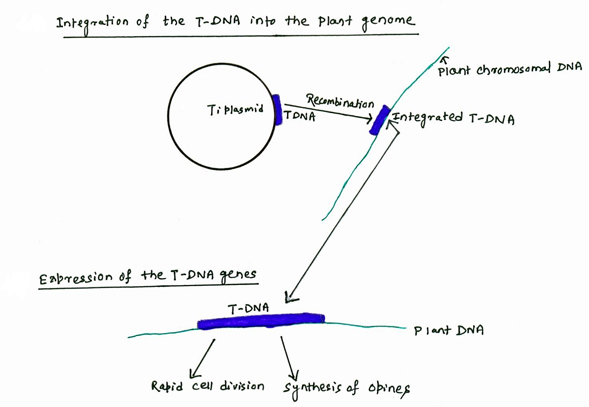Agrobacterium tumefaciens—nature’s smallest genetic engineer
The Ti plasmid of Agrobacterium tumefaciens, is of great importance. [4]
A. tumefaciens is a soil microorganism that causes crown gall disease in many species of dicotyledonous plants. [4] The ability to cause crown gall disease is associated with the presence of the Ti (tumor inducing) plasmid within the bacterial cell. This is a large (greater than 200 kb) plasmid that carries numerous genes involved in the infective process. A remarkable feature of the Ti plasmid is that, after infection, part of the molecule is integrated into the plant chromosomal DNA. This segment, called the T-DNA, is between 15 and 30 kb in size, depending on the strain. It is maintained in a stable form in the plant cell and is passed on to daughter cells as an integral part of the chromosomes. [4]
But the most remarkable feature of the Ti plasmid is that the T-DNA contains eight or so genes that are expressed in the plant cell and are responsible for the cancerous properties of the transformed cells. [4] These genes also direct synthesis of unusual compounds, called opines, that the bacteria use as nutrients. A. tumefaciens genetically engineers the plant cell for its own purposes. [4]
Image source: http://upload.wikimedia.org/wikipedia/commons/d/d1/Ti_plasmid.svg
Genes in the virulence region are grouped into the operons virABCDEFG, which code for the enzymes responsible for mediating transduction of T-DNA to plant cells.[22]
· virA codes for a receptor which reacts to the presence of phenolic which leak out of damaged plant tissues.[24]
· virB encodes proteins which produce a pore/pilus-like structure.[23]
· virC binds the overdrive sequence.[23]
· virD1 and virD2 produce endonucleases which target the direct repeat borders of the T-DNA segment,
· vir E Binds to T-strand protecting it from nuclease attack, and intercalates with lipids to form channels in the plant membranes through which the T-complex passes, [23] beginning with the right border.[24]
· virG (TRANSCRIPTIONAL FACTOR) activates vir-gene expression after binding to a consensus sequence,[23] once it has been phosphorylated by virA.[24]

Image source: http://www.discoverbiotech.com/image/image_gallery?uuid=c2aa87a0-9c4c-4783-a69c-1f396e3b7aa5&groupId=11406&t=1332308806765
Click on the link to watch the animation for better understanding:
- Gene Cloning & DNA Analysis- An Introduction, T.A.Brown. fifth edition, blackwell publishing, 2006
- Schrammeijer, B., Beijersbergen, A., Idler, K.B., Melchers, L.S., Thompson, D.V., Hooykaas, P.J.J. (2000). "Sequence analysis of the vir-region from Agrobacterium tumefaciens octopine Ti plasmid pTi15955. Journal of Experimental Botany 51 (347): 1167 1169. doi:10.1093/jexbot/51.347.1167. PMID 10948245
- Alexander N. Glazer, Hiroshi Nikaidō (2007). Microbial biotechnology: fundamentals of applied microbiology. Cambridge University Press. ISBN 0-521-84210-7.
- http://upload.wikimedia.org/wikipedia/commons/d/d1/Ti_plasmid.svg
- http://highered.mcgraw-hill.com/olcweb/cgi/pluginpop.cgi?it=swf::535::535::/sites/dl/free/0072437316/120078/bio40.swf::The%20Ti%20Plasmid
